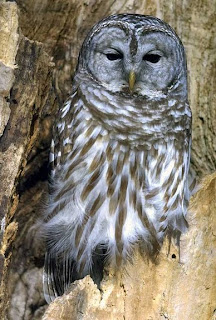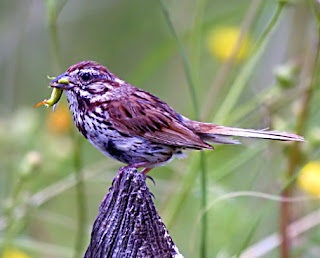Adaptations for Flight 3
Nervous modifications
The cerebellum is enlarged (the area of the brain responsible for coordination and balance). In birds, the cerebellum is relatively bigger than in any other animal.
Birds' eyes are very large. Proportionally, the eyes are 10-15% larger than people. Some hawks have eyes our size but they have much smaller bodies. Sometimes eyes touch inside the head. The retinas are 1-1.5 % thicker than mammals'. The rods and cones are more abundant in fovea (where cones are concentrated) = million cones/sq. mm (200,000 in people). A hawk's vision is 8x better than a person's. Bird eyes have oil droplets that increase contrast and reduce haze. Hawks and other fast flyers often have 2 fovea: central for side vision, temporal for front vision. Most sensory cells are in upper part of eye.
Bird eyes have 2 peculiar features: 1) pectin, a folded vascular structure projecting from optic nerve. The exact funtion is unclear: nutrition and shading? 2) sclerotic ring, ring of bones around edge of eye. The ring fixes it so eye can't move: makes for telescope-like eye! Bird compensates for lack of movement by having really flexible neck.
The cerebellum is enlarged (the area of the brain responsible for coordination and balance). In birds, the cerebellum is relatively bigger than in any other animal.
Birds' eyes are very large. Proportionally, the eyes are 10-15% larger than people. Some hawks have eyes our size but they have much smaller bodies. Sometimes eyes touch inside the head. The retinas are 1-1.5 % thicker than mammals'. The rods and cones are more abundant in fovea (where cones are concentrated) = million cones/sq. mm (200,000 in people). A hawk's vision is 8x better than a person's. Bird eyes have oil droplets that increase contrast and reduce haze. Hawks and other fast flyers often have 2 fovea: central for side vision, temporal for front vision. Most sensory cells are in upper part of eye.
Bird eyes have 2 peculiar features: 1) pectin, a folded vascular structure projecting from optic nerve. The exact funtion is unclear: nutrition and shading? 2) sclerotic ring, ring of bones around edge of eye. The ring fixes it so eye can't move: makes for telescope-like eye! Bird compensates for lack of movement by having really flexible neck.
Swainson's Hawk




Comments
Post a Comment